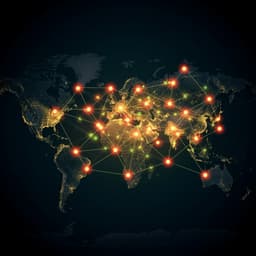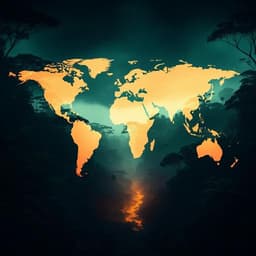
Environmental Studies and Forestry
The shift of phosphorus transfers in global fisheries and aquaculture
Y. Huang, P. Ciais, et al.
Research conducted by Yuanyuan Huang and colleagues reveals that global fish production is reshaping phosphorus flows, posing challenges for aquaculture. With significant phosphorus usage in aquaculture, meeting future efficiency goals by 2050 will require innovative solutions.
Playback language: English
Introduction
Phosphorus (P) is a vital element for life, and its increasing human demand has quadrupled P inputs into the biosphere since pre-industrial times, primarily through mineral P fertilizers. Long-term P scarcity threatens food production due to depleting ore deposits. Conversely, uneven P distribution leads to regional surpluses, causing eutrophication in inland and coastal waters, degrading water quality and biodiversity. Current mitigation strategies focus on recycling and better management of soil, crop, and livestock P flows. Global fisheries, a substantial contributor to global animal protein supply (~17% in 2013), represent an overlooked subsector impacting land and aquatic nutrient flows. Annual global fish harvest has drastically increased, from 19 Tg in 1950 to 169 Tg in 2016. Aquaculture, the fastest-growing food production sector, is expanding rapidly but raises concerns about environmental sustainability due to its reliance on wild fish and crop livestock for feeds, water and land resource use, and other environmental impacts. This study aims to quantify the net impact of global fisheries on P flows, improving understanding of P biogeochemical cycles and providing targets for P management.
Literature Review
Existing global-scale P budgeting has primarily focused on agriculture, highlighting the significant contribution of phosphate fertilizers (82.4% to cropland and pasture) and livestock manure to P runoff into aquatic systems. However, the global fishery sector’s role in P fluxes has been underrepresented. Previous studies have focused on agriculture's P impact (e.g., Bouwman et al., 2009; Peñuelas et al., 2013; Lun et al., 2018), emphasizing the substantial losses of P not absorbed by plants, leading to water pollution. The contribution of fisheries to land-aquatic nutrient flows has been investigated (e.g., Maranger et al., 2008; Doughty et al., 2016; Otero et al., 2018), showing that fisheries can transfer P from aquatic to land systems. However, the lack of data-driven quantification of anthropogenic impacts of fishery production on large-scale P budgets has been a significant gap in previous literature. This study intends to address this gap by utilizing diverse data sources to quantify the impact of global fisheries on P flows.
Methodology
The study reconstructs global P budgets driven by fishery production using extensive data from global fishery production databases (FAO FishStatJ and Sea Around Us), fish stoichiometry (whole-body P concentration data for 1164 records of 224 fish species), and aquaculture farm system-level PUE estimates (168 entries). A P-retention efficiency (PRE) database from controlled feeding experiments was also compiled. PUE is defined as the ratio of harvested to input P, calculated at the farm level, accounting for various feeds (including commercially manufactured feeds, farm-made feeds, and recycled by-products) and fertilizers. PRE is the fraction of P recovered in harvested fish biomass per feed P intake from controlled feeding experiments. The study quantifies the net anthropogenic P flow between land-human and aquatic systems via fisheries and aquaculture (P-net = P-harvest - P-input). P-harvest is estimated from fish production and whole-body P concentration. P-input is derived from P-harvest and aquaculture system-level PUE. PRE serves as a reference PUE. The study utilizes a Monte Carlo method to assess uncertainty, considering variations in whole-body P concentration and fish biomass. Continental and country-level P budgets are analyzed, and future scenarios are projected based on aquaculture production projections and varying PUE assumptions. The analysis considers factors such as diverse aquaculture practices, species variations, and regional differences in PUE. The study differentiates between freshwater and marine aquaculture, and among finfish, crustacean, and mollusk species, to provide comprehensive insights. It uses a conservative approach to uncertainty estimation by considering a range of uncertainty levels (0%, 50%, 100%) for fish biomass and randomly sampling data points to reflect the distribution's skewness.
Key Findings
Global P-harvest (wild + aquaculture) increased from 0.21 Tg P yr−1 in 1950 to 1.10 Tg P yr−1 in 2016, while P-input increased from 0.01 Tg P yr−1 to 2.04 Tg P yr−1. The global estimate of P-input for 2010 (1.46 Tg P) aligns with the World-Fish database (1.11 Tg P). P-harvest was the dominant pathway transferring P from aquatic to land systems (compared to other pathways, such as anadromous fish, seabird colonies, and sea salt deposition). Initially, P-harvest exceeded P-input (positive P-net), reaching a maximum of 0.54 Tg P yr−1 in 1986. The rapid expansion of aquaculture after the 1980s, coupled with low PUE, led to a negative P-net around 2004. In 2016, the global P-net was -0.95 Tg P yr−1, indicating a net P transfer from land to aquatic systems. Asia has primarily driven this negative shift, while other continents (Europe, America, Africa, and Oceania) showed positive P-net. Country-level analysis reveals that increased P-input from developing Asian countries (China contributing 60% of the global increase) and decreased P-harvest in some developed countries contributed to the overall negative P-net trend. A baseline scenario projecting to 2050, assuming stable wild fish production and current PUE, predicts a negative P-net of -2 Tg P yr−1. Achieving P-neutrality by 2050 requires increasing the global average PUE to 48%. Analysis of PUE data (ranging from 1–167%) and PRE data from controlled experiments (median 37%, 75th percentile 52% for finfish) suggests that this target might be technologically feasible through improvements in feeding efficiency and adopting low-impact production systems, such as integrated multitrophic aquaculture (IMTA) and integrated aquaculture/agriculture (IAA). The study highlights that the global fishery P input in 2016 (2.06 Tg P yr−1) was significant, although smaller than P loads from crop livestock. It also notes that a substantial portion of aquaculture P-input ends up in freshwater systems. The study compares the P-net per unit food protein supply from fish-driven food production with that from crop-livestock systems, demonstrating that while the fish system generates lower P loading than the crop-livestock system overall, aquaculture itself has a significant negative P-net.
Discussion
The findings highlight the significant and previously underappreciated role of global fisheries, particularly aquaculture, in altering global phosphorus cycles. The shift from a positive to a negative P-net emphasizes the need for improved phosphorus use efficiency in aquaculture. The large-scale P budget is significantly affected by the global fishery sector, with the negative P-net posing a risk to aquatic ecosystems. Regional differences, with Asia showing a stark contrast to other continents, underscore the importance of context-specific solutions. The possibility of achieving a P-neutral fishery by 2050, while technologically feasible based on current best practices, presents a substantial challenge that requires widespread adoption of improved aquaculture practices and technology. The comparison with crop-livestock systems emphasizes the importance of considering the entire food system when assessing P impacts. Future research could focus on optimizing PUE across various aquaculture practices, considering the economic and social factors influencing adoption of improved technologies. The study’s data limitations regarding aquaculture input data and assessment of uncertainty, particularly in biomass estimations, necessitates further work using more comprehensive and detailed data sources. The study’s findings advocate for integrating fishery sector considerations into broader P assessment and mitigation strategies.
Conclusion
This study provides a comprehensive data-driven analysis of the global fishery's impact on phosphorus flows, revealing a significant shift in net phosphorus transfer from aquatic to land systems. Achieving P-neutrality in the fishery sector by 2050 is a significant challenge requiring substantial improvements in aquaculture PUE. Technological solutions exist, but their implementation requires overcoming economic and practical barriers. Future research should focus on integrating fisheries into broader P management strategies, considering both technological and socio-economic aspects. The study underscores the interconnectedness of various sectors in shaping global P cycles, calling for multi-sectoral approaches to optimize P use and mitigate environmental impacts.
Limitations
The study acknowledges limitations in data availability, particularly concerning aquaculture feed and fertilizer input data. Uncertainty in fish biomass estimations also impacts the precision of P budget calculations. The focus on aggregate global and regional trends limits insights into local-scale variations in P fluxes. The study relies on existing databases, which may not fully capture all aspects of fish production, including unreported or illegal fishing activities. The analysis assumes that discarded fish do not impact land-aquatic P transfers. The lack of time-series data on PUE hampers the assessment of trends in efficiency improvements.
Related Publications
Explore these studies to deepen your understanding of the subject.







